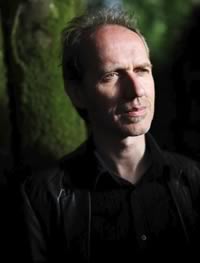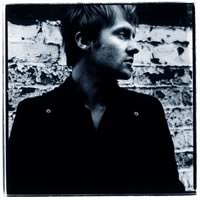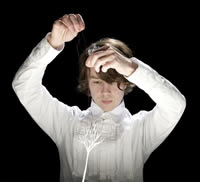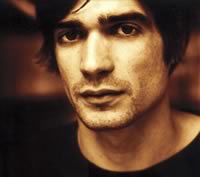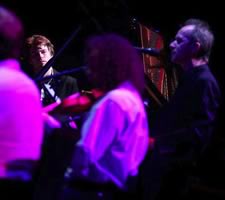Following the release of Foxlight, we were lucky enough to persuade Iarla Ó Lionaird to address a few questions about the album itself and his other projects. Iarla Ó Lionaird took time out while working with ‘The Gloaming’ in the U.S. to provide some expansive insights for visitors to Folk Radio UK.
With Invisible Fields you were working with familiar collaborators on familiar territory. Foxlight was far less of a ‘home’ based album, yet you’ve said you were able to put more of yourself into its creation. Was it important from the outset to take your work beyond the more familiar surroundings?
To be honest initially I was hoping to do the bulk of the recording for Foxlight in the familiar surroundings of my home and my studio in Kilkenny; but time and other reasons to do with logistics, and I suppose some creative reasons as the project progressed, it gravitated more and more towards London. It wasn’t really something that I had planned so much as something that just developed over time. As Leo [Leo Abrahams] became increasingly stuck into the production, and the assets and the ideas came into view and began to be realized increasingly (and I’m speaking here about the larger and more complex elements) then one gravitated to the central production node, so to speak the studio, where the work is happening and that was his base. I think it was quite natural that the work would gravitate towards his studio in London as time progressed.Iarla Ó Lionaird
As it turned out I still did a lot of vocal recordings at home and we frequently exchanged updated files to each other over the web. It was very interesting to see how these tracks were developing; how they grew, changed, gaining in definition and force as time went on. Then also my song writing, I think it also progressed in parallel – one process feeding into the other in a coeval loop almost. The initial setting off point for most of the songs still remained in my headspace, which is kind of here in Ireland and didn’t seem to be that much influenced by being in London working on it. When you’re in, the studio is quite hermetic an existence from day to day. You really don’t get to see much of the outside world and I do remember we applied ourselves pretty much to the task at hand. Of course it’s so intense and interesting and what happens is that this intensity gets a hold of you and you give in to it, and that’s when the process of collaborative creation is at its most exciting and rewarding.
Leo Abraham’s input seems to perfectly compliment your own approach to music, what brought you together?
What brought us together was pure happenstance really. I’d been doing some live shows promoting Invisible Fields for a year or so, and I was working with a very talented guitarist call Steve Jones. He often told me that in the event of him not being able to do a show for availability reasons or whatever, there was this friend of his that I should check out. He spoke so highly of Leo Abrahams, when it actually happened that Steve wasn’t available to play some show I naturally gave Leo a call. We did some beautiful shows in cathedrals and stuff and straight away I realized that he had a very unusual, a very sensitive and special skill set, quite unlike any other guitar player I had encountered. He had an unusual approach to playing guitar and I remember he probably was not the first, but certainly had the most elegant implementation of computer laptop approach and technique with the guitar, and also a very fresh intuitive take on the sonics of the instrument and all its textural possibilities. It’s no surprise really that he has worked with some very serious producers because he brings a very defined and yet very open sensibility to the table. I remember at one point the composer Gavin Bryars heard him rehearsing with me in London and immediately inquired as to his availability for shows I was doing with Gavin. He had a tremendous impact on that project. Later on then as time progressed I began thinking about how I would do a new album. I’d been scratching around at home in a studio on my own and I thought I should really ask Leo to help me shape this record.Leo Abrahams
I have a tendency not to deliberately repeat myself if I can avoid it and, at the risk of sounding precious, I kind of make sure that I set up circumstances were I have to work with people that I’ve never recorded with before. In that way I create a sort of experiment in creativity if you like, that is automatically generative and you don’t fall back on your old habits quite as much. So with Leo in the room it was pretty much a blank slate and it gave rise to quite a few surprises as well. I think I may have expected when I started working with him that there would be quite a preponderance of his beautiful and glassy sort of textual guitar, which is what I was accustomed to hearing in the live front, but Leo thought that we should adopt a more naturalistic approach to the sonics of the new recordings, instead of what I had done with Invisible Fields which was quite layered, electronic and very processed.
As we continued doing more sessions in studio together we developed a musical language that was giving rise to a much more open sound, more up-close certainly from the vocal point of view, and with real instruments playing beautifully. I should say that Leo also brought a huge amount of other talent to bear on the record to achieve the overall effect. I’m speaking here of Neil McColl an extraordinary musician on acoustic guitar, the Strings duo Geese and cellists Oliver Coates and Lucy Railton. All of these artists contributed hugely to the sound and feel of the tracks, responding as they did to the voice primarily. I should also mention that we were lucky to have Leafcutter John doing these beautiful textural electroacoustic layers for us and Simon Edwards providing a multiplicity of solutions for bass.Leafcutter John
Similarly, contributions from Jon Hopkins add to the album’s elegance. How did that collaboration come about and to what extent did his input influence the album?
Well Leo and Jon are quite good friends and worked at the time out of the same studio space in London. I was keen to have some piano on the album and wasn’t quite sure how we would do it. In some ways I felt, as did Leo, that we wanted to be much more minimalist in our approach with this instrument this time as it is such a huge presence in any track. Thankfully Jon was agreeable to having a go and I think the results speak for themselves. He is a unique player, compositional and mysterious I would say.Jon Hopkins
Not content with developing new approaches to traditional music, Iarla has also ventured forth into the world of New Classical. In 2011 he collaborated with Irish composer Donnacha Dennehy on Grá agus Bás (Love and Death)…
Last year’s release from Donnacha Dennehy, Grá agus Bás, featured songs written specifically for you to perform. Although the songs were inspired by the Sean-nós tradition, was it daunting to approach this new material?
This was a truly daunting and challenging project for me. To begin with my ability to read music, particularly in a live sight-reading context, was simply not at the races and on top of this the piece in question was quite complex. It took quite a bit of time and a lot of patience on the part of the composer and conductor to get it into shape. But it was a great experience and its definitely opened my ears to the “New Classical” field and whetted my appetite for more projects like this one. I’m planning on a few other pieces at the moment with other composers and it’s very exciting.
Iarla’s haunting vocals first became widely heard in his work with the Afro Celts…
Are there any plans for more studio work or live dates with Afro Celt Sound System?
Well not for me at any rate. Last year I closed my account with the band after releasing our best of album. It seemed like a good time to draw a line under it. I’m very proud of the achievements of the band and the experience it gave me but now I feel that for me at any rate its time to move on.
You’ve come together with Thomas Bartlett, Dennis Cahill, Martin Hayes and Caoimhín Ó Raghallaigh to create ‘The Gloaming’. How was the US debut received and when can we look forward to a studio release?
This is a project that’s very dear to my heart, as most of my colleagues in The Gloaming are old friends whom I’d worked with over the years on other projects. But also I love the sound we have been able to create as a band. It’s unique stuff I think, and I am looking forward to playing more and more shows. I think New York went very well, we are booking shows all over the world now and we expect to record some time this summer for sure, possibly in New York.The Gloaming
On Foxlight there’s a deliberate shift towards including more original material than on Invisible Fields. Did you see Foxlight from the start as a vehicle for you own song writing?
Well when I started out working on an untitled album, as it was at the beginning, I began simply by exploring various themes and lyrical ideas that I was coming up with in my own studio. I may have done this for little under a year; creating sounds, recording some found sounds, writing lyric fragments – so yes I suppose that from the very beginning of the project it was more oriented towards new writing than interpretation of older material. And as the project progressed, and especially with Leo’s arrival on the scene, this process accelerated and expanded in importance. Nevertheless I had in mind quite a few traditional songs that I had been working on in the live front over the previous few years, with a mind to recording these in new ways. But as it turned out they were one of the last things we did actually do from a timeline point of view. In the overall I guess this album placed more emphasis on songs that I wrote myself with Leo and I think that though it wasn’t always a conscious decision to move in that direction I am quite happy now with this balance.
Invisible Fields Session
As Folk Radio UK said in the review of Foxlight, comparisons with Invisible Fields are inevitable. Despite the six year gap and numerous other projects, do you see Foxlight as direct follow up?
It’s a difficult one to answer to be frank. Although the public sees albums as both distinct and as related for me at any rate it’s more a development, a further step in the overall creative journey if you will. We took quite a different approach on Foxlight in particular, with regard to the placement and pre-eminence of the voice, and with regard to using far less synthesis and relying much more on performance and real instruments played by individuals, each responding creatively to the track and making a real contribution. In that sense I see Foxlight as quite apart from Invisible Fields but nevertheless it has strong links to it thematically.
Are there any plans to take Foxlight to a live audience?
Well I did some shows earlier in the autumn but I have not done any intensive touring yet. Maybe later this year.


